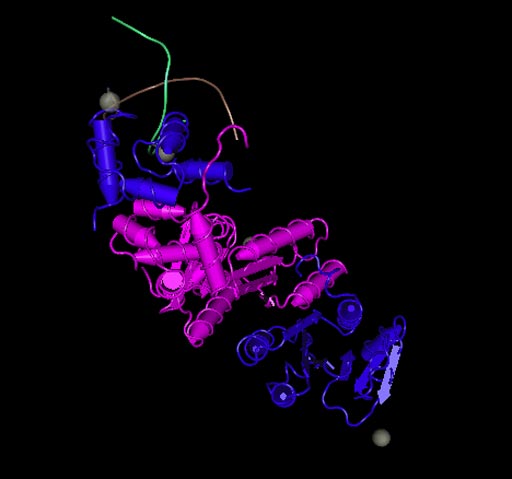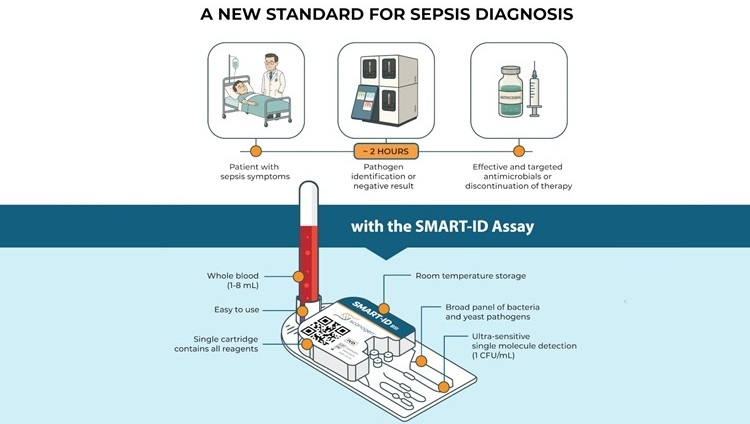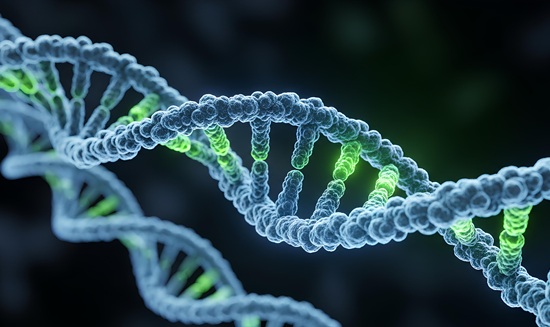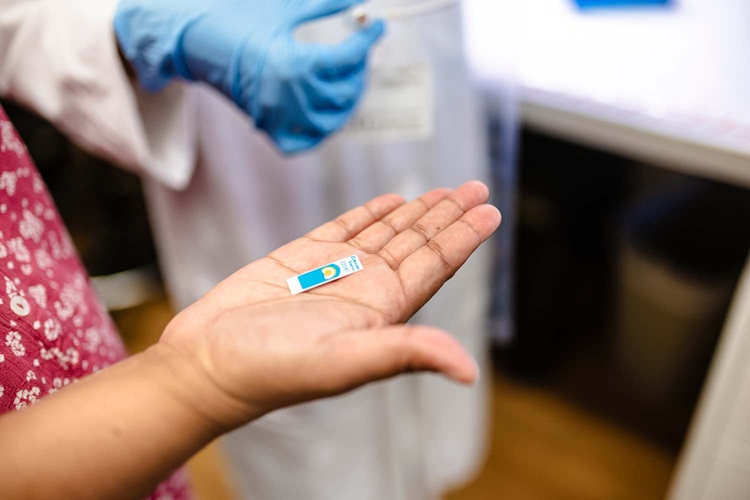Discovered Inherited Syndrome Predisposes Body to Cancer
|
By LabMedica International staff writers Posted on 02 Oct 2017 |

Image: A ribbon model of an X-ray diffraction based 3D structure of FANCM- FAAP24 complex, as shown in ID# 4BXO of the Protein Database (PDB) (Photo courtesy of Coulthard R et al, 2013, PDB).
The syndrome was found and characterized by studying patients with biallelic mutations (mutations in both inherited gene copies) in the FANCM gene. These mutations predisposed the body to development of tumors and to hypersensitivity to and rejection of chemotherapy treatments. Contrary to what has been thought, the study suggests that mutations in the FANCM gene does not cause Fanconi anemia, a rare disease that affects ~ 1 of every 100,000 children.
A research team led by Jordi Surrallés, professor at Autonomous University of Barcelona (UAB; Barcelona, Spain) and Genetics Unit director at Hospital de la Santa Creu i Sant Pau, identified this genetic syndrome in which patients are predisposed to early formations of tumors and to chemotherapy toxicity.
In one of two co-published studies, first-author Massimo Bogliolo, from the Centre for Biomedical Network Research on Rare Diseases (CIBERER) group led by Jordi Surrallés, analyzed biallelic FANCM mutations in 3 individuals. Despite the number of patients being low in these types of studies (dealing with rare diseases), it was observed that the patients did not present any congenital malformations or hematological phenotype that could suggest being affected by the disease Fanconi anaemia, yet they did have an early onset of cancer and toxicity to chemotherapy.
In the second study, researchers from Dr Surrallés' group and the group led by Javier Benítez at the CNIO and CIBERER confirmed that women with biallelic mutations in the FANCM gene did not develop Fanconi anaemia, but did present a higher risk of breast cancer, chemotherapy toxicity, and chromosomal fragility. This study was coordinated by Paolo Peterlongo of the Milan Institute of Molecular Oncology and included the participation of several hospitals and research centers of Italy, Germany, Spain, and Sweden.
Given that in 2005 the biallelic mutation was observed in patients suffering from Fanconi anaemia "it was thought that biallelic mutations in the FANCM gene caused Fanconi anaemia. But we have now demonstrated that it is not so, given that in the two studies there were 8patients with these mutations and none of them had anemia," Dr. Surrallés. The patients however had suffered from cancer at very early ages and presented chemotherapy toxicity. In view of this newfound syndrome, the authors recommend modifying the clinical monitoring of patients with biallelic FANCM mutations and taking precautions when using chemotherapy and radiation therapies.
The researchers also conducted functional genetic complementation tests, an important type of analysis in mass sequencing projects in which there are several mutated genes and it is not clear which are the source of the disease. Patients’ cells showed a clear phenotype of chemical hypersensitivity to DEB (a DNA damaging agent) such the cells did not survive high doses of DEB. In contrast, when a healthy FANCM gene copy was transferred (using lentiviral transductions) into cells from patients, the researchers observed reversal of this phenotype: the cells behaved as if they were healthy, with a response similar to that of a healthy donor. This functional study provided a demonstration that the gene causing the disease is FANCM and that these biallelic FANCM mutations are of a pathogenic nature.
The two studies, by Bogliolo M et al and by Catucci I et al, were co-published August 24, 2017, in the journal Genetics in Medicine.
Related Links:
Autonomous University of Barcelona
A research team led by Jordi Surrallés, professor at Autonomous University of Barcelona (UAB; Barcelona, Spain) and Genetics Unit director at Hospital de la Santa Creu i Sant Pau, identified this genetic syndrome in which patients are predisposed to early formations of tumors and to chemotherapy toxicity.
In one of two co-published studies, first-author Massimo Bogliolo, from the Centre for Biomedical Network Research on Rare Diseases (CIBERER) group led by Jordi Surrallés, analyzed biallelic FANCM mutations in 3 individuals. Despite the number of patients being low in these types of studies (dealing with rare diseases), it was observed that the patients did not present any congenital malformations or hematological phenotype that could suggest being affected by the disease Fanconi anaemia, yet they did have an early onset of cancer and toxicity to chemotherapy.
In the second study, researchers from Dr Surrallés' group and the group led by Javier Benítez at the CNIO and CIBERER confirmed that women with biallelic mutations in the FANCM gene did not develop Fanconi anaemia, but did present a higher risk of breast cancer, chemotherapy toxicity, and chromosomal fragility. This study was coordinated by Paolo Peterlongo of the Milan Institute of Molecular Oncology and included the participation of several hospitals and research centers of Italy, Germany, Spain, and Sweden.
Given that in 2005 the biallelic mutation was observed in patients suffering from Fanconi anaemia "it was thought that biallelic mutations in the FANCM gene caused Fanconi anaemia. But we have now demonstrated that it is not so, given that in the two studies there were 8patients with these mutations and none of them had anemia," Dr. Surrallés. The patients however had suffered from cancer at very early ages and presented chemotherapy toxicity. In view of this newfound syndrome, the authors recommend modifying the clinical monitoring of patients with biallelic FANCM mutations and taking precautions when using chemotherapy and radiation therapies.
The researchers also conducted functional genetic complementation tests, an important type of analysis in mass sequencing projects in which there are several mutated genes and it is not clear which are the source of the disease. Patients’ cells showed a clear phenotype of chemical hypersensitivity to DEB (a DNA damaging agent) such the cells did not survive high doses of DEB. In contrast, when a healthy FANCM gene copy was transferred (using lentiviral transductions) into cells from patients, the researchers observed reversal of this phenotype: the cells behaved as if they were healthy, with a response similar to that of a healthy donor. This functional study provided a demonstration that the gene causing the disease is FANCM and that these biallelic FANCM mutations are of a pathogenic nature.
The two studies, by Bogliolo M et al and by Catucci I et al, were co-published August 24, 2017, in the journal Genetics in Medicine.
Related Links:
Autonomous University of Barcelona
Latest Molecular Diagnostics News
- CLIA Test Identifies Head and Neck Cancer Recurrence from Post-Surgical Lymphatic Fluid
- New 15-Minute Hepatitis C Test Paves Way for Same-Day Treatment
- Ovarian Cancer Assay Outperforms Traditional Tests in Early Detection
- Ultrasensitive Method Detects Low-Frequency Cancer Mutations
- Blood Test Enables Non-Invasive Endometriosis Detection
- New Blood Biomarkers Help Diagnose Pregnancy-Linked Liver Complication
- Simple Urine Test to Revolutionize Bladder Cancer Diagnosis and Treatment
- Blood Test to Enable Earlier and Simpler Detection of Liver Fibrosis
- Genetic Marker to Help Children with T-Cell Leukemia Avoid Unnecessary Chemotherapy
- Four-Gene Blood Test Rules Out Bacterial Lung Infection
- New PCR Test Improves Diagnostic Accuracy of Bacterial Vaginosis and Candida Vaginitis
- New Serum Marker-Editing Strategy to Improve Diagnosis of Neurological Diseases
- World’s First Genetic Type 1 Diabetes Risk Test Enables Early Detection
- Blood Test to Help Low-Risk Gastric Cancer Patients Avoid Unnecessary Surgery
- First-Of-Its-Kind Automated System Speeds Myeloma Diagnosis
- Blood Protein Profiles Predict Mortality Risk for Earlier Medical Intervention
Channels
Clinical Chemistry
view channel
Online Tool Detects Drug Exposure Directly from Patient Samples
Doctors often rely on patient interviews and medical records to determine what medications a person has taken, but this information is frequently incomplete. People may forget drugs they used, take over-the-counter... Read more
Chemical Imaging Probe Could Track and Treat Prostate Cancer
Prostate cancer remains a leading cause of illness and death among men, with many patients eventually developing resistance to standard hormone-blocking therapies. These drugs often lose effectiveness... Read moreHematology
view channel
MRD Tests Could Predict Survival in Leukemia Patients
Acute myeloid leukemia is an aggressive blood cancer that disrupts normal blood cell production and often relapses even after intensive treatment. Clinicians currently lack early, reliable markers to predict... Read more
Platelet Activity Blood Test in Middle Age Could Identify Early Alzheimer’s Risk
Early detection of Alzheimer’s disease remains one of the biggest unmet needs in neurology, particularly because the biological changes underlying the disorder begin decades before memory symptoms appear.... Read more
Microvesicles Measurement Could Detect Vascular Injury in Sickle Cell Disease Patients
Assessing disease severity in sickle cell disease (SCD) remains challenging, especially when trying to predict hemolysis, vascular injury, and risk of complications such as vaso-occlusive crises.... Read more
ADLM’s New Coagulation Testing Guidance to Improve Care for Patients on Blood Thinners
Direct oral anticoagulants (DOACs) are one of the most common types of blood thinners. Patients take them to prevent a host of complications that could arise from blood clotting, including stroke, deep... Read moreImmunology
view channel
Blood Test Could Detect Adverse Immunotherapy Effects
Immune checkpoint inhibitors have transformed cancer treatment, but they can also trigger serious immune-related adverse events that damage healthy organs and may become life-threatening if not detected early.... Read more
Routine Blood Test Can Predict Who Benefits Most from CAR T-Cell Therapy
CAR T-cell therapy has transformed treatment for patients with relapsed or treatment-resistant non-Hodgkin lymphoma, but many patients eventually relapse despite an initial response. Clinicians currently... Read moreMicrobiology
view channel
Blood-Based Diagnostic Method Could Identify Pediatric LRTIs
Lower-respiratory tract infections (LRTIs) are a leading cause of illness and death worldwide, and pneumonia is the leading infectious cause of death in children under five, claiming the lives of over... Read more
Rapid Diagnostic Test Matches Gold Standard for Sepsis Detection
Sepsis kills 11 million people worldwide every year and generates massive healthcare costs. In the USA and Europe alone, sepsis accounts for USD 100 billion in annual hospitalization expenses.... Read moreRapid POC Tuberculosis Test Provides Results Within 15 Minutes
Tuberculosis remains one of the world’s deadliest infectious diseases, and reducing new cases depends on identifying individuals with latent infection before it progresses. Current diagnostic tools often... Read more
Rapid Assay Identifies Bloodstream Infection Pathogens Directly from Patient Samples
Bloodstream infections in sepsis progress quickly and demand rapid, precise diagnosis. Current blood-culture methods often take one to five days to identify the pathogen, leaving clinicians to treat blindly... Read morePathology
view channel
Rapid Low-Cost Tests Can Prevent Child Deaths from Contaminated Medicinal Syrups
Medicinal syrups contaminated with toxic chemicals have caused the deaths of hundreds of children worldwide, exposing a critical gap in how these products are tested before reaching patients.... Read more
Tumor Signals in Saliva and Blood Enable Non-Invasive Monitoring of Head and Neck Cancer
Head and neck cancers are among the most aggressive malignancies worldwide, with nearly 900,000 new cases diagnosed each year. Monitoring these cancers for recurrence or relapse typically relies on tissue... Read more
Common Health Issues Can Influence New Blood Tests for Alzheimer’s Disease
Blood-based tests for Alzheimer’s disease are transforming diagnosis by offering a simpler alternative to spinal taps and brain imaging. However, many people evaluated at memory clinics also live with... Read more
Blood Test Formula Identifies Chronic Liver Disease Patients with Higher Cancer Risk
Chronic liver disease affects millions worldwide and can progress silently to hepatocellular carcinoma (HCC), one of the deadliest cancers globally. While surveillance guidelines exist for patients with... Read moreTechnology
view channel
Machine Learning Models Diagnose ALS Earlier Through Blood Biomarkers
Amyotrophic lateral sclerosis (ALS) is a rapidly progressive neurodegenerative disease that is notoriously difficult to diagnose in its early stages. Early symptoms often overlap with other neurological... Read more
Artificial Intelligence Model Could Accelerate Rare Disease Diagnosis
Identifying which genetic variants actually cause disease remains one of the biggest challenges in genomic medicine. Each person carries tens of thousands of DNA changes, yet only a few meaningfully alter... Read moreIndustry
view channel
BD and Penn Institute Collaborate to Advance Immunotherapy through Flow Cytometry
BD (Becton, Dickinson and Company, Franklin Lakes, NJ, USA) has entered into a strategic collaboration with the Institute for Immunology and Immune Health (I3H, Philadelphia, PA, USA) at the University... Read more



















